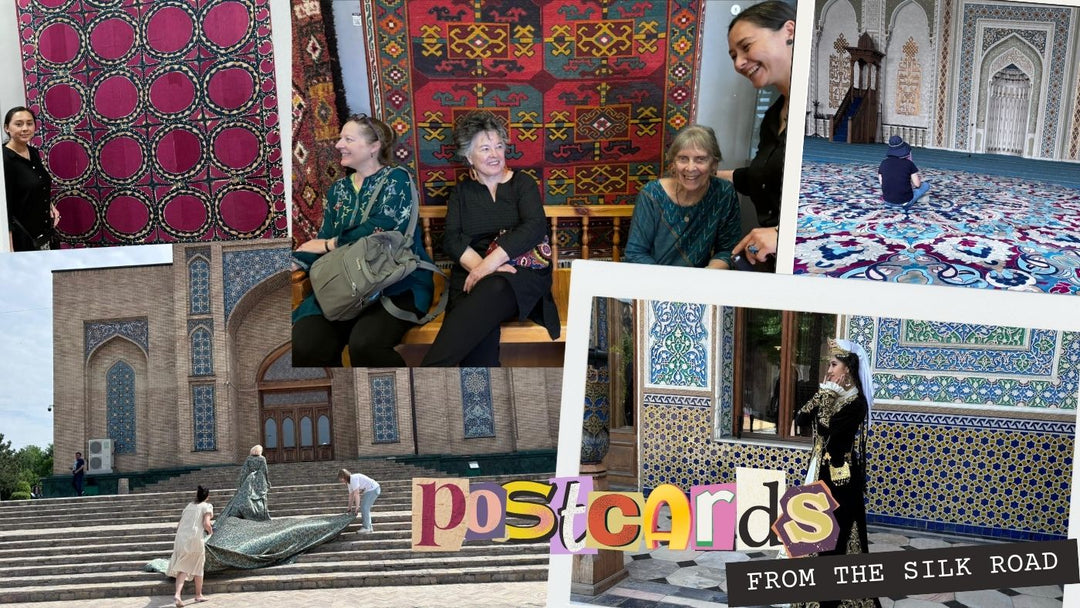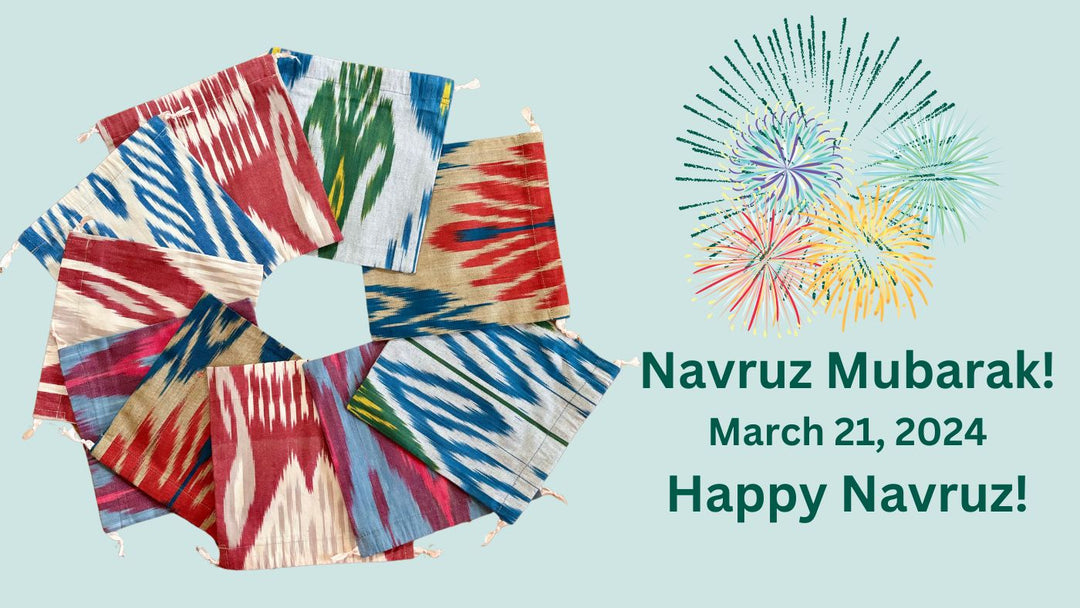Many of our textile products at HoonArts include authentic ikat fabrics from Uzbekistan in Central Asia. If you do a Google search, you fill find that “ikat” is a very trendy item. Not long ago, I saw a full page advertising spread in Travel and Leisure which was promoting all things “ikat,” with a focus on Central Asian patterns. What was most interesting to me, though, was that not a single product on the page appeared to use authentic ikat fabrics, but rather, all seemed to be factory manufactured products, using American designs. So I thought I would share with you some information about authentic Central Asian ikats and the place and culture from which they come.
“Ikat” is a dyeing technique used to create patterns on fabric by employing a resist dyeing process on the threads prior to dyeing and weaving the fabric. In ikat the resist is formed by binding individual threads or bundles of threads with a tight wrapping applied in the desired pattern. (Ikat is an Indonesian/Malay language word, which, depending on the context, can mean the nouns “cord, thread, knot” and the finished ikat fabric as well as the verbs "to tie" or "to bind.") Once bound to create patterns, the threads are then dyed, by hand. The bound parts of the thread do not take on the dye color, whereas the unbound, exposed parts are colored. The tightly bound areas are waxed before dyeing so that the dye does not penetrate when the bundles are soaked in the dye. To create new patterns, the bindings may then be altered and the threads dyed again with another color. This process may be repeated multiple times to produce elaborate, multicolored patterns. When the dyeing is finished, all the bindings are removed and the threads are woven into cloth.

Bundling ikat threads.

Dying ikat threads.

Artisan weaving ikat fabric in Dushanbe, Tajikistan on a traditional narrow hand loom, operated with foot pedals. Note that the pattern appears on both warp and weft threads, one of the most difficult ikat patterns to weave.
In other resist-dyeing techniques, such as tie-dye and batik, the resist is applied to the woven cloth, whereas in ikat the resist is applied to the threads before they are woven into cloth. Because the surface design is created in the threads, rather than on the finished cloth, the pattern is the same on both sides of the fabric.
A characteristic of ikat textiles is an apparent "blurriness" to the design. The blurriness is a result of the extreme difficulty the weaver has lining up the dyed yarns so that the pattern comes out perfectly in the finished cloth. The blurriness can be reduced by using finer threads or by the skill of the craftsperson. Ikats with minimal blurriness, multiple colors and complicated patterns are more difficult to create and therefore often more expensive. However, the blurriness that is so characteristic of ikat is often prized by textile collectors.

Elaborate multicolored ikat pattern, with the characteristic blurriness. The Margilan ikats (and all the Central Asian ikats) have very distinctive and easily recognizable patterns, although they range from simple two color patters to extremely complex, multi-colored patterns. The entire process is very demanding and labor intensive. These ikat fabrics are woven by hand on narrow looms which are generally 15.7" to 23.6" wide (mostly 16” wide) and have beams ending every 225cm. This beam produces a characteristic stripe in the pattern at this interval. This stripe, far from being a flaw, is one way to distinguish an authentic hand-woven ikat from a machine/factory produced product. The Margilan ikats are typically produced by small, family-owned workshops, which jealously guard their techniques and patterns. The most highly skilled artisans typically weave no more than 2 yards of fabric per day. The Margilan ikats are woven out of many different types of materials. Most of the HoonArts products using ikat fabrics are either 100% cotton or a 60% silk/40% cotton blend, both known locally as “adras.” The 100% silk ikats are known as “atlas.”

Cotton adras, showing characteristic stripe from beam and two-sided pattern.


Modern pillow cover from Armugon Handicrafts of the Zerafshan region of Tajikistan, combining traditional hand-woven adras ikat (60% silk/40% cotton) with hand-embroidered suzani patterns.

HoonArts volunteer, Denise Bucci, modeling a kimono-style jacket crafted from hand-woven ikat fabric from Margilan, Uzbekistan. Ikat fabrics have been used in Central Asia for hundreds of years in clothing and other textile products. Ikat patterns continue to be used in modern-day Tajikistan for elaborate traditional costumes as well as daily wear. More recently, they are being adopted by fashion designers for use in haute couture designs that are taking the fashion world by storm.

Jewish students with their teacher in Samarkand, Uzbekistan, early 1900's.

Everyday wear in the Pamir mountains of Tajikistan.

Holiday attire for children in Tajikistan also uses ikat fabrics and patterns.

Work attire in the city.

Traditional dress, Tajikistan.

Traditional dress, Tajikistan.

Haute couture, by one of Tajikistan's most popular modern fashion designers.
Margilan is the modern survivor of an ancient Central Asian silk weaving tradition. According to European legend, Margilan was founded by Alexander the Great. On a lunch stop, he was supposedly given chicken (“murgh” in Persian) and bread (“nan” in Persian), from which the town took its name. More reliable records indicate that Margilan was an important stop on the Silk Road by the 9th century AD, along the route going across the Alay Mountains to Kashgar.

The town is the location of Uzbekistan’s largest traditional silk factory, the Yodgorlik Silk Factory. Employing over 2,000 workers, everything is done in the traditional manner, for an annual output of some 250,000 square meters of highly premium silk cloth. The neighboring Margilan Silk Factory employs 15,000 workers using modern machinery, and produces some 22 million square meters per year. It is uncertain when the secrets of silk production came to the Fergana Valley, but certainly, Margilan has been active in the industry since ancient times.
While Margilan is part of modern-day Uzbekistan, most westerners do not realize that the Fergana Valley where it is located is a multi-ethnic region which for most of its history was administered as a single unit. Today, the Fergana Valley extends across three countries (Uzbekistan, Tajikistan and Kyrgyzstan) and continues to host major populations from each ethnic group. The artistic traditions arising out of this region thus share a common history, rather than being distinctively Uzbek, Tajik or Kygyz.

The Fergana Valley, located in the southeast corner of Central Asia, is enclosed by the Tian Shan Mountains to the north and the Gissar-Alai range to the south. Almost 8,500 square miles in size, the valley of flat plains is easily distinguished from the surrounding terrain of mountains, deserts and treeless steppes. The Fergana Valley is also the most fertile agricultural area in the region, due to the Syr Darya River and its numerous tributaries, water resources that are the subject of controversy in the region. With principal crops of wheat, cotton, rice, vegetables and fruit, the Fergana Valley is also a major source of food for Central Asia. This agricultural productivity has also made the Fergana Valley the most densely populated area of Central Asia.
The current division of the Fergana Valley among three countries is the result of Soviet political policy. For most of its history, the Fergana Valley was part of a unified political entity. In ancient times, it was part of Transoxiana, a province of the Persian Empire, where it played an important role in the Silk Road trade from China to the Middle East and Europe. Modern Khujand, Tajikistan (home of Munira Akilova, the designer for Armugon Handicrafts and Ozara, the handicraft arm of the National Association of Business Women of Tajikistan, and itself a major stop on the Silk Road) has long been known as the “gateway” to Fergana. The Mongols conquered the area in the 13th Century and incorporated it into the Chagatai Khanate. While political boundaries shifted as Turkic groups and Islam spread into the area, Fergana was always administered as a single unit. The 18th Century saw the area as the Kokand Khanate, which included eastern Uzbekistan, southern Kazakhstan and most of Tajikistan and Kyrgyzstan. When Imperial Russia moved into the area in the 19th Century, political control shifted again but the Fergana Valley remained intact, moving from the Kokand Khanate to the Fergana province of Russian Turkestan in 1876. The collapse of Imperial Russia and the rise of the Soviet Union, however, led to profound changes in Central Asia in general, and Fergana in particular. The Soviets created provincial boundaries that grouped the Central Asian population into distinct nationalities, when previously identities were largely based on clan, region or religion. The ethno-linguistic labels of Uzbek, Kygyz or Tajik were thus not used until the early 20th century, and clan ties and regionalism are still a major factor today.
Furthermore, boundaries in the modern sense did not exist in the region before the Soviets, since most of the population (particularly Kazakhs, Turkmen and Kygryz) were nomadic, while the Tajiks and Uzbeks were more settled. The Soviets forcibly settled the populations of Central Asia and created new, artificial boundaries defining the Soviet Republics of Uzbekistan, Tajikistan and Kyrgyzstan. These borders, designed by Josef Stalin mostly for administrative purposes, were also intended to prevent the rise of a political entity that might challenge Moscow’s authority--another example of the age-old “divide and conquer” principle. The new boundaries, however, did not reflect either the natural geographic features of the Fergana Valley or the new national/ethnic identities of the peoples in these republics. The complex, almost serpentine boundaries within the Fergana Valley did not have much practical impact during Soviet times, since the entire region was under centralized Moscow control. With the collapse of the Soviet Union, however, a new wave of nationalism swept throughout the former Soviet Republics. That nationalism continues to affect relations between the nations of the Fergana Valley, despite the multi-ethnic population in each and the remaining family ties that ignore borders.
The situation was further complicated by the 5 year Civil War in Tajikistan following independence, which destroyed much of the country’s infrastructure and considerably delayed Tajikistan’s entry into the international market, including the handicraft sector. As a consequence, while handicrafts from Kyrgyzstan and Uzbekistan have developed a reputation in the US and Europe, Tajik handicrafts (which reflect the same cultural history and artistic traditions) have only a tiny footprint in the US. In late 2014, I formed HoonArts, the only US business importing Tajik handicrafts on a systematic basis, specifically to help the artisans of Tajikistan create a sustainable US market for their products. Our entire reason for being is to build community and empower the artisans of Tajikistan (and other Central Asian countries) through their own craftsmanship.
This history in the Fergana Valley has led to some strange modern consequences, from the Western point of view. For example, artistic cooperation between artisans in Kyrgyzstan and Tajikistan is common. The Union of Craftsmen of Tajikistan is part of a major Central Asian handicraft initiative under the framework of the EU and Cesvi-funded project "Handicraft and Business through Regional Integration and Fair Trade Market", which is focused on combining resources and expertise to enhance integration between Tajikistan and Kyrgyzstan in the handicraft sector. On the other hand, cross-border relations between Tajikistan and Uzbekistan are fragile. The border crossing between Uzbekistan and Tajikistan between Samarkand (Uzbekistan) and Panjakent (Tajikistan) was closed by Uzbekistan in 2010, and remains closed today, even though Samarkand and Panjakent were adjacent stops on the Silk Road for hundreds of years and the ethnic majority in Samarkand is Tajik, not Uzbek. Other border crossings between Uzbekistan and Tajikistan are unreliable, and subject to arbitrary closure or restriction and there is a widely acknowledged concern about corruption among border guards. (The absence of a reliable land route for shipping from Tajikistan, which is land-locked, is one of the key reasons that all our Tajik products are shipped to the US by air.) When I asked my ikat supplier in Margilan, Uzbekistan if she could perhaps export ikat fabrics direct to Armugon Handicrafts in Tajikistan and avoid the middlemen, she reported that it was simply too complicated because of political issues, and that it was much easier to export to the US than Tajikistan.
I hope that this history gives you a taste for the complexity of both the ikat fabrics and the cultural and political history from which they come. It also means that now, when you hear someone talk about “Uzbek ikats,” you will know that it reflects the arbitrary divisions imposed during Soviet times, rather than any intrinsic ethnic or cultural distinction (or superiority) between the artisans of Tajikistan and Uzbekistan. You should also be able to distinguish a mass-produced commercial "ikat" product from the genuine hand-woven fabric that is the product of centuries of artistic tradition in Central Asia.







Leave a comment